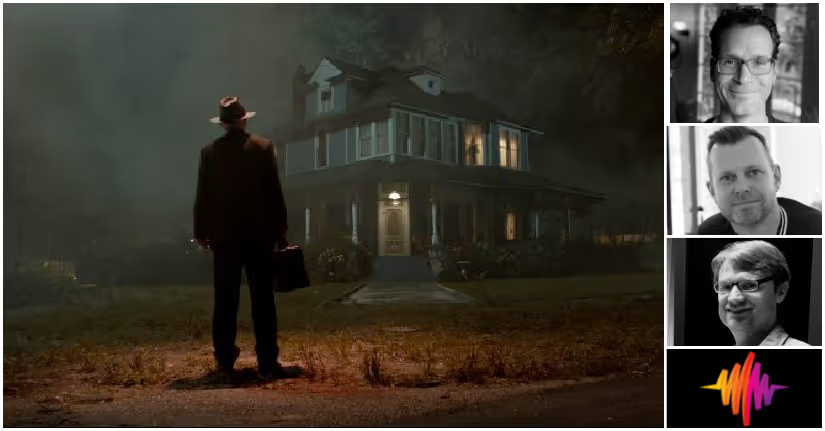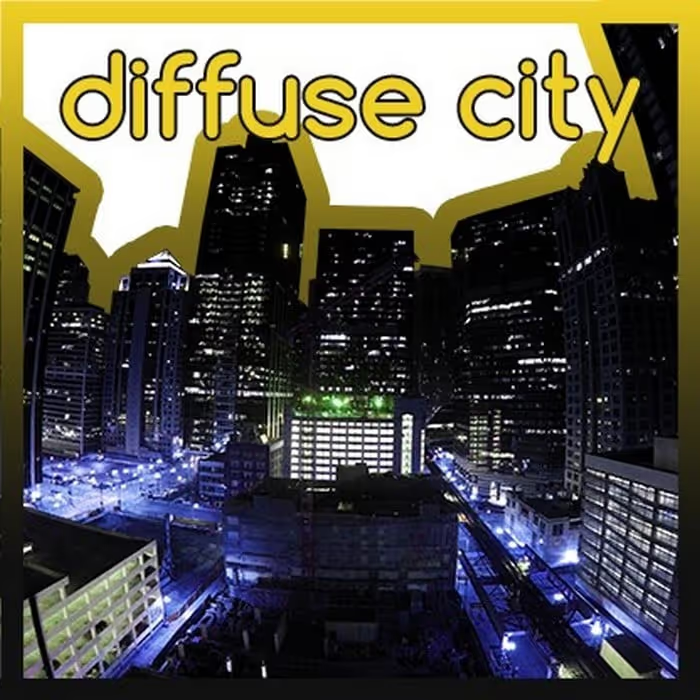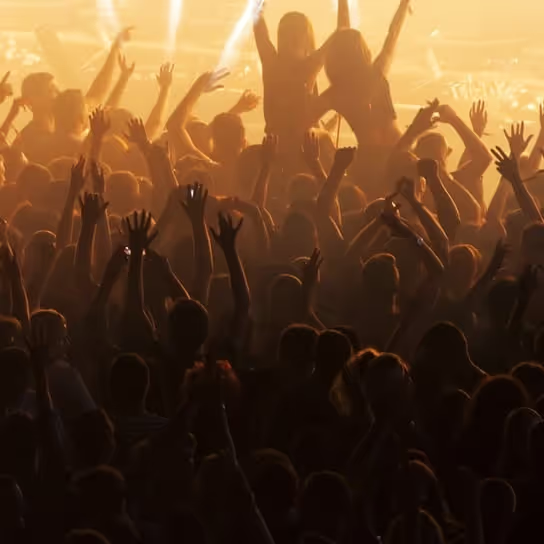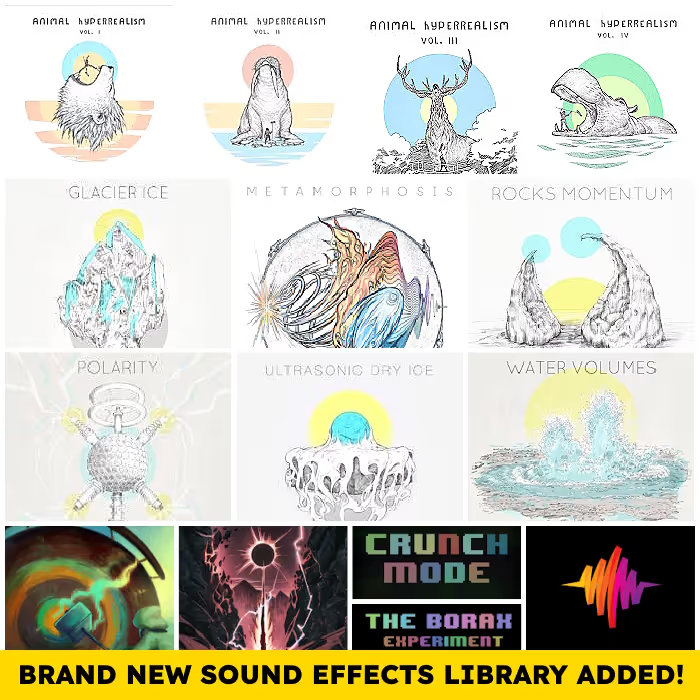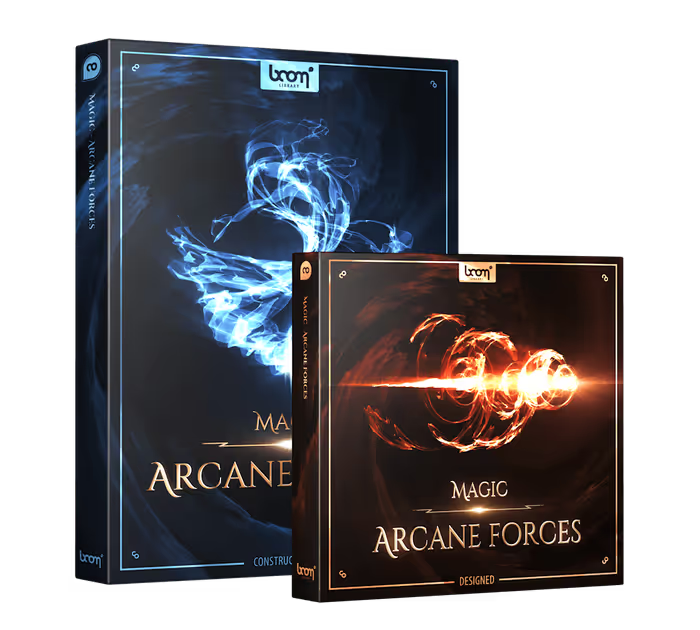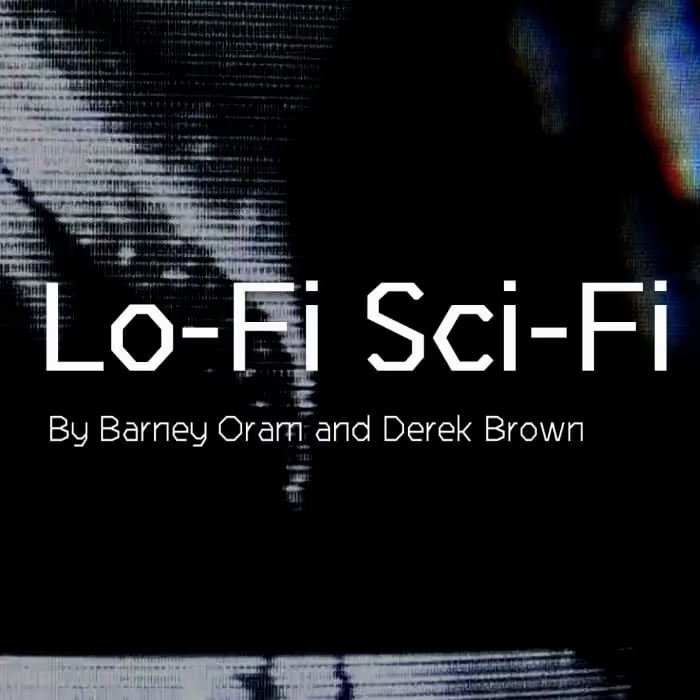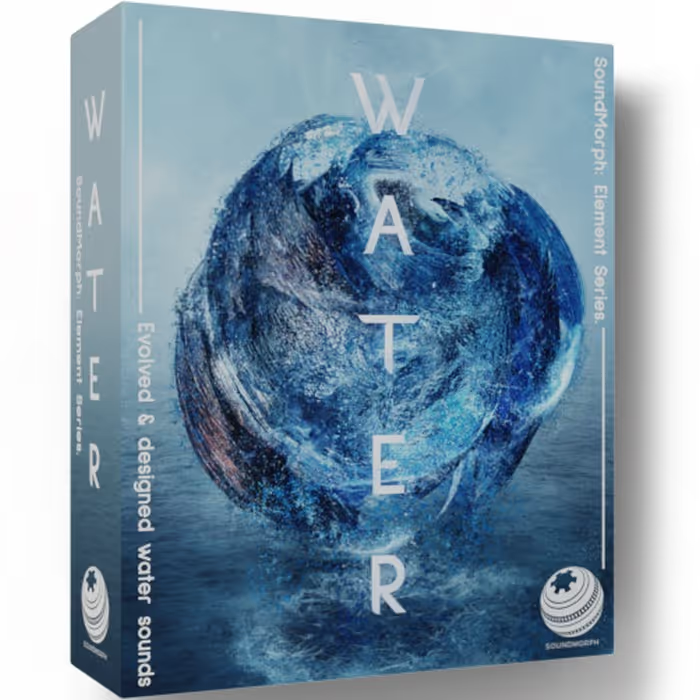Based on the true story of Ed and Lorraine Warren, The Conjuring horror film franchise tries to maintain a realistic aesthetic when it comes to supernatural scares. Demonic voices are within the range of human vocal capabilities. Jump scares are created from organic, real-world sounds. The real Lorraine Warren herself visited the film set of The Conjuring (2013), and didn’t object to the way director James Wan was telling her story. That adhesion to realism has continued through each new film added to The Conjuring Universe, no matter the director. It’s part of the brand’s DNA.
The latest release, The Conjuring: The Devil Made Me Do It , was directed by Michael Chaves, who also directed another Conjuring Universe film, The Curse of La Llorona.
Chaves worked with WB Sound‘s MPSE award-winning supervising sound editor/sound designer Jay Jennings, Oscar-nominated re-recording mixer Julian Slater, and MPSE award-winning re-recording mixer Mike Babcock, final mixing the film in native Dolby Atmos on Stage 5 at WB Sound in Burbank.
Here, Jennings, Slater, and Babcock talk about how the film uses everyday sounds to create scares, their use of dynamic range, sound selection, and panning in the Dolby Atmos surround field to craft a mix that draws the audience in (without hitting them over the head!), how the demonic vocals were designed, and much more!
THE CONJURING: THE DEVIL MADE ME DO IT – Official Trailer
This is the third The Conjuring film, and the eighth installment in the Conjuring Universe. What did you and director Michael Chaves want to bring to The Conjuring: The Devil Made Me Do It in terms of sound aesthetic?
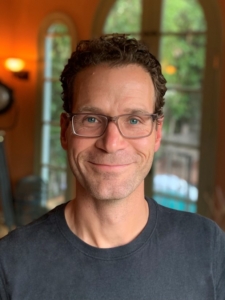
Jay Jennings (JJ): Michael [Chaves] brought a thoughtful and mature sensibility on how to use sound design effectively as a storytelling tool, which was very refreshing as some filmmakers under-appreciate the power that sound design can have. He was really interested in exploring that side of the palette and he pushed us in some directions that we were happy to go in with him.
For instance, if you’re familiar with The Conjuring franchise, you know that many of the scares are “quiet scares” — meaning they’re real sounds played in odd or unexpected ways, meant to put you on edge rather than blast you out of your seat with a super loud sound. Sometimes they’re just simple sounds but presented in a way that is jarring or strange.
We had a lot of fun as a team exploring what that approach would look like for this latest installment in the franchise.
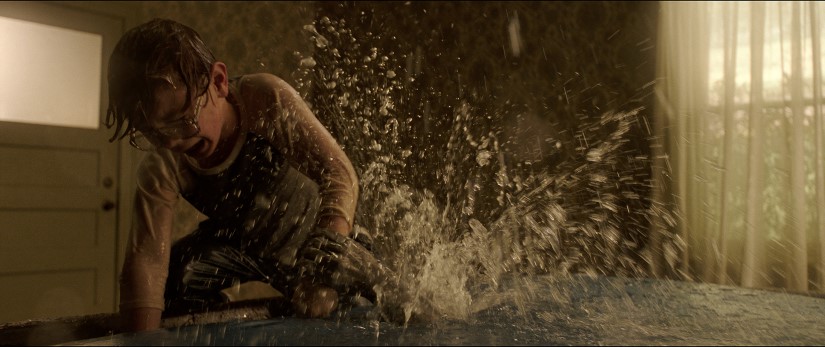
When did you get started on this film? Were you brought in pretty early or were they already into the picture cut by the time you were brought in?
JJ: This film was a little unique for me as I came into it late in the process, with about two months left in the schedule. It had already been in post for about a year and a half (some of that being exacerbated by the pandemic and the inability to preview for audiences in a theater). So it was already well underway when I joined the team.
It was more about focusing in on and refining what was working…
A lot of really great work had already been done so it wasn’t a start-from-scratch situation. It was more about focusing in on and refining what was working and, in the areas where our director wanted to go in a new direction, creating and shaping those moments.
One example of this is David’s exorcism at the opening of the film. It was the first sequence that Michael wanted us to take a pass on and present a new vision. We had less than a week — no pressure! Using a combination of existing material and newly created designs, we sent our version back to Michael for approval and, thankfully, he loved it. He was really encouraged by the new direction as showcased in that sequence, which was an important milestone for us, a style check of sorts. It set the tone for the film.
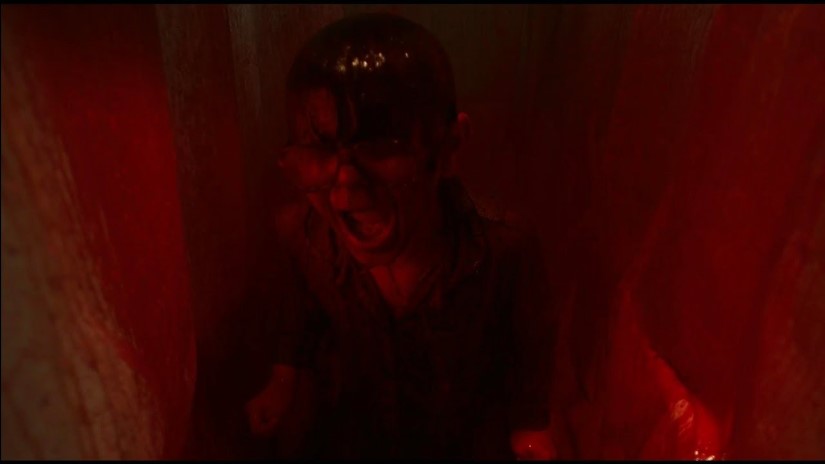
What were some things that you were able to bring sonically to the opening exorcism sequence?
JJ: The two biggest concepts were contrast and dynamic range. When David is awoken in his bed by the knocking on his door that sets the stage for how dynamic this soundtrack will be. The first knocks are gentle, kind of quiet, just enough to wake him up. Then the second set of knocks explode out of near silence, motivating David to jump from his bed and run to the bathroom. We designed this intentionally in Dolby Atmos, with the gentle knocking mostly in the center speaker, and the heavy pounding in all the speakers. That pounding on the door may be one of the loudest sound moments in the film. A great way to start a horror movie!
The two biggest concepts were ‘contrast’ and ‘dynamic range.’
The shaking of the bathroom door is another instance of contrast and dynamic range, very intentionally being bold and strong and then dropping out to very, very quiet to put the audience on edge and to take away any sense of security that they might have by eliminating sound. You take away anything that can tell the audience how to feel so that they’re just on edge immediately.
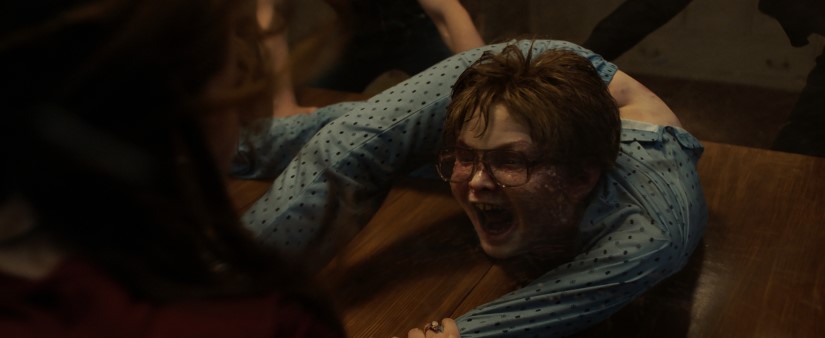
For the exorcism of David, can you talk about your vocal design for when he’s possessed?
JJ: Julian Hilliard, the actor that plays David Glatzel, was great. He’s probably my favorite actor in the whole movie. His on-set performance, struggling, screaming and being held down on the table are so convincing. We didn’t want to affect his production screams and efforts because they were so good. So aside from some subtle sound design enhancements when he’s foaming at the mouth and convulsing on the table, that’s just his cleaned-up production track.
With the goal of keeping it firmly based in reality, I knew that the vocals for the possessed David needed to be structured around a human performance.
When Father Gordon splashes the holy water on him, David’s body arches up and contorts as he becomes possessed by the demon and he expels this awful roar. That’s the point where we shifted from the actor’s performance to sound design. I wanted this to feel real; not over-the-top Hollywood but something more documentary-style that it was actually happening. Whatever vocalizations came out of David’s mouth needed to be believable, like his 8-year old vocal cords could actually produce those sounds. We wanted to truly shock the audience, rather than pull them out of the film with a disassociated sound.
With the goal of keeping it firmly based in reality, I knew that the vocals for the possessed David needed to be structured around a human performance. (There were a couple of versions that relied pretty heavily on animal sounds but Michael steered us away from those.) So I started experimenting and recording my own voice, screaming and yelling and making all sorts of crazy noises.
Once I had a basic roadmap down, I did some subtle processing and enhancements with other textures, not wanting to twist it so far away that it didn’t sound like a human being anymore. Sometimes I find that if I can hear it in my imagination, it’s easiest to open up a mic and perform the sound rather than doing exhaustive searches through my library in search of “the perfect sound.” If I know I can make it, I’ll just make it. And then I’ll manipulate it from there.
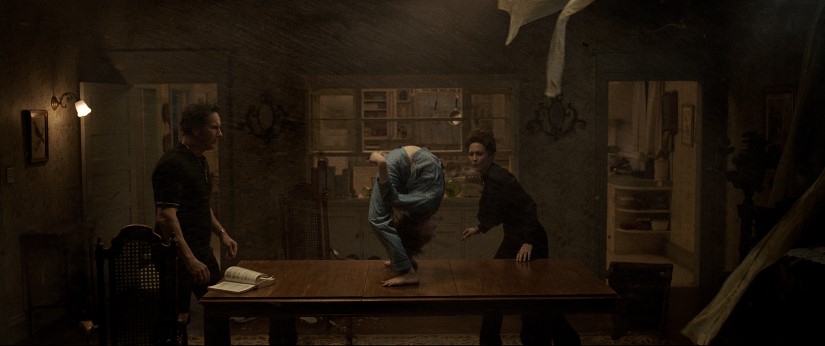
For David’s line, “I’ll stop your heart old man,” who ended up delivering that?
JJ: We had several choices available to us, from David’s on-set recording to several group actors, but what ended up in the final mix was my voice.
When Michael asked, ‘Who is that?’
I said, ‘Well, that’s my voice. But please don’t feel that you need to use it. I’m not precious about it. I want what’s best for the film.’
He said, ‘ No, I like it!’
So that’s what ended up going into the movie.
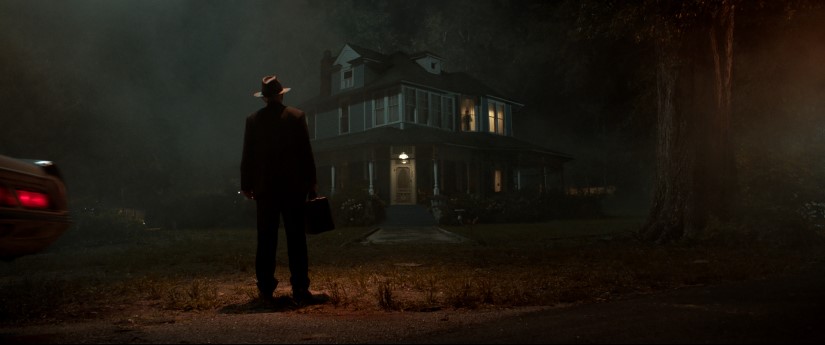
At the end of the movie, we hear the actual audio recording of the exorcism of David. How much did that scare the crap out of you? And, did that impact your approach to his demonic vocals?
JJ: It was shocking, for sure. Michael wanted us to listen to it as a reference but I wasn’t sure I wanted to. You can’t un-hear that.
I had designed David’s exorcism scene before I heard that recording, and was thankful that the sound design felt similar in tone to the actual recording from 1981. On that tape, David’s voice went lower and got gravelly and growly, but also went high and maniacal at times, a similar approach I had taken with the sound design. And that’s the way that we wanted to portray it, to convey as much horror as possible but still keep it real and keep the audience on board the whole time.
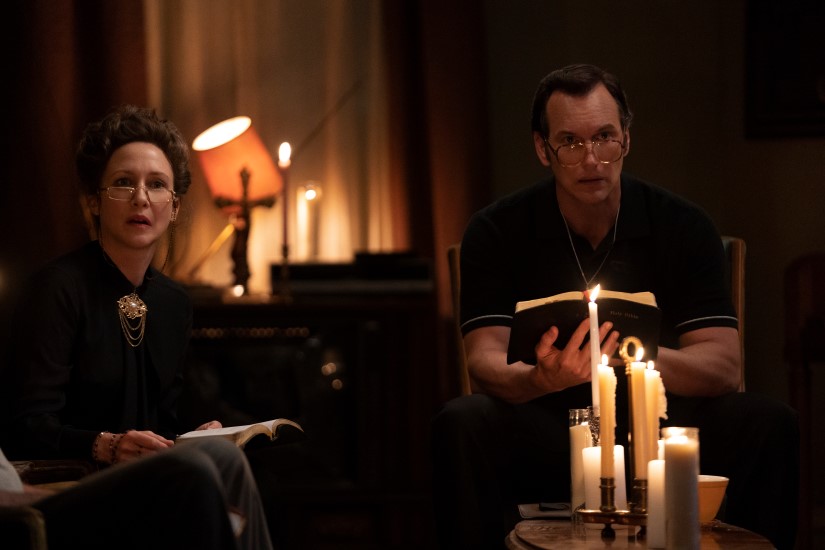
The dynamic range of this film is incredible and that scene with David in the bathtub is a great example of that. In terms of the mix, Mike and Julian, can you talk about how you guys shaped that sequence and some of the decisions that you made on the dub stage?
Mike Babcock (MB): For that scene, originally there were some winds and tones built that were played really low and it felt creepy and it felt really cool. To experiment, we tried taking everything out except for some select small things that you hear. And it just had this different spine tingliness.
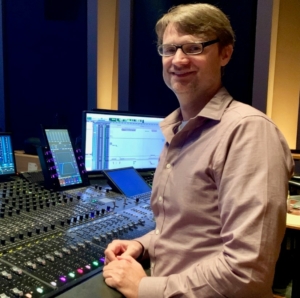
It’s unfortunate that the word ‘theatrical’ is overused, but it should be stressed really that this movie’s sound approach is ‘theatrical.’ We had the ability to not use any sound in places and have that be effective. We took everything out and all you hear is just David’s light movement; there’s nothing. In fact, there are a couple of places where there’s what I would call digital zero. So when you have something really small, like the hands coming over the bar of the shower, there’s something extremely creepy about that. Actually, those hands are living up in the ceiling. There was quick agreement in the room. Like, whoa, that’s even better.
Julian Slater (JS): I think also it helps when you know that the audience wants to be scared. You’ve got sounds that, in another genre of movie, aren’t necessarily scary or creepy but they take on a new meaning. Personally, I haven’t done a huge amount of horror movies or scary movies and it was quite an eye-opener to learn the process of what is scary. What is a scary sound? It can be, obviously, something that’s dark and thematic of the franchise, but there are other things as well that can be used for maximum effect.
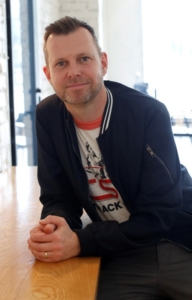
When we do a preview of the film and get notes back from the audience, we get a heads-up as to what things are scaring them; it gives us license to then push it further. And so we’re utilizing not necessarily the scariest of sounds in everyday life, but when playing it to an audience who wants to be scared, it works.
Also, we previewed it to an audience who hadn’t actually been in the cinema for over a year and so they desperately wanted to be scared. They wanted the full Monte, as we say in England. They really wanted to have that experience because they’d been missing it for so long.
Seeing a film in the theater is a communal experience. If you are in a room with 300 other people, there’s a thing that happens in the audience. It’s a collective on-edge feeling, isn’t it? There’s a vibe that feeds an echo chamber. You feel the vibe of the room being on tenterhooks and that feeds into your own fears and expectancy of what’s about to happen.
MB: Something we were definitely discussing after their preview was trying to stay away from cheap scares. So it’s not just really quiet and then there’s this big “jump scare,” as they call them.
It was trying to not be cheap with just jarring the audience into something. It was trying to find these clever moments of not just hitting something with a huge bang. Maybe it was a rumble. Maybe it was just something that was “off.” Maybe it could be a different kind of sound than just a gigantic impact – screaming at the audience, ‘There’s a scare here!”
JS: Yeah, that’s totally true. The temptation was there, but again, Michael [Chaves] our director shepherded us very much in the direction of being of clever with some of these scares, as opposed to just hitting the audience over the head sonically.
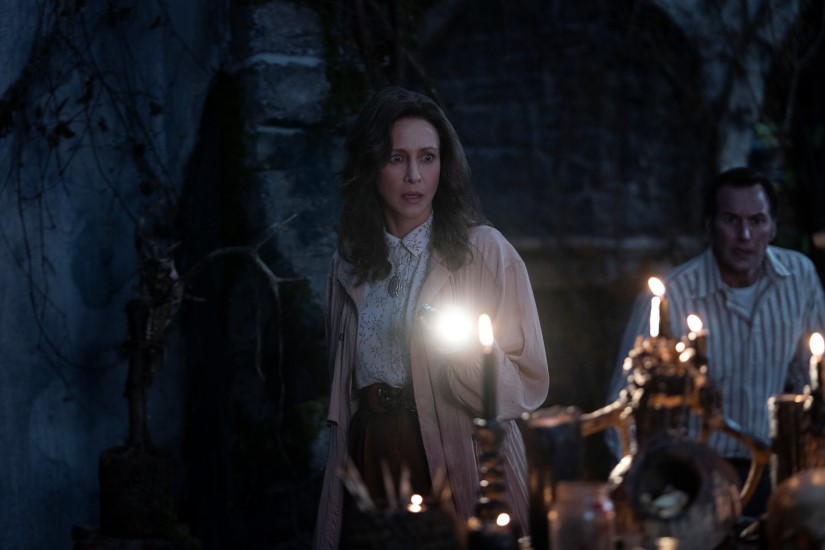
Mixing a horror film in Dolby Atmos seems like the ideal situation. With so many speakers, there are so many opportunities to put little noises everywhere. How were you able to take advantage of the Atmos format for The Conjuring 3?
JS: I would say it was probably the reverse psychology of that. At the will of our director, we actually tried to scale things back because I certainly had a tendency to want to use all the speakers as much as possible. And, our director was very clear and insistent on actually coming down in level and coming down in using all the speakers to make the big moments even bigger. There’s a very particular style for The Conjuring movies, which isn’t necessarily all out with speakers set to 10 the whole time.
There’s a very particular style for ‘The Conjuring’ movies, which isn’t necessarily all out with speakers set to 10 the whole time.
When we did our first run, just me and Mike, we mixed it pretty full-on in places. And then we’d step back and think about how to pare it down and how to be a bit cleverer than just trying to hit the audience over the head with using all the speakers all the time.
So, for me personally, it was an interesting lesson in using Atmos in a kind of different way, to pare it down at times, using the dynamic range of the speaker system — from zero to 10 — using everything in between. So it wasn’t full on the whole time.
Two words we were using a lot were ‘focus’ and ‘dynamics.’
MB: Yeah, that’s a great way to put it. Two words we were using a lot were focus and dynamics. There are definitely moments where things are all around you, but one thing with Atmos is that if you’re using the entire canvas all the time, in some ways it’s bludgeoning you over the head with everything. But in this way, when you’re focusing on certain moments — like if something’s over your head — you get a little bit more of a spine-tingling situation if there’s a lot of space around that, whether it’s dynamic space or spatial space.
At the end of the day, yes, it’s a lot of fun to have that whole real estate to play with. And we definitely used it, just not all the time.
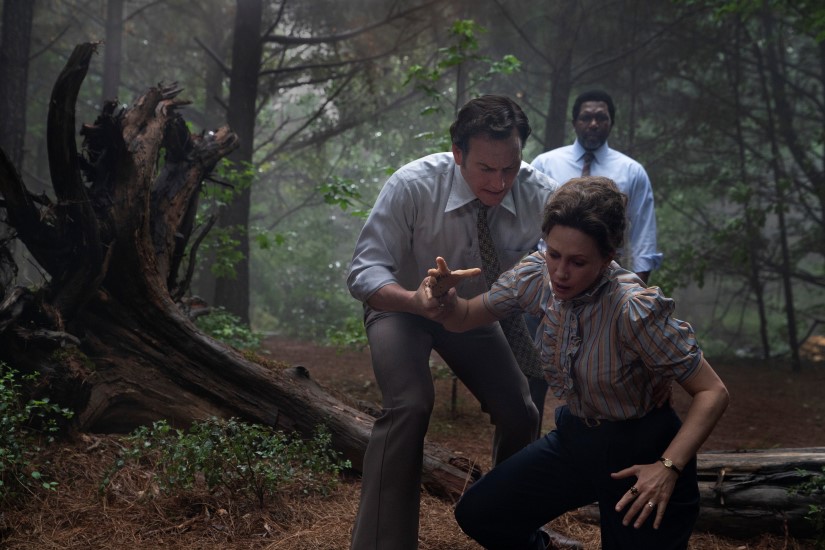
Looking at Lorraine’s visions, which play out in a more subjective realm, the sounds for those are tailored to the event that’s happening. For instance, when Lorraine is in the woods searching for Jessica, you hear all those great wood creaking, tree bending sounds as the darkness descends on her in the vision. Can you talk about the design of that scene?
…he wanted to hear the leaves in the canopy above us swirling and twisting around, as if the entire world is going back in time…
JJ: Each time she had a vision, like you said, they’re a little bit different. Michael wanted us to incorporate sounds that could be found in Lorraine’s surroundings, like the trees in the forest, the train whistles in the distance, the knife in the hand of the witch. So when she’s leaning down to touch the forest floor in the spot where the girl had been murdered, instead of relying on ‘design-y’ effects, he wanted to hear the leaves in the canopy above us swirling and twisting around, as if the entire world is going back in time, to signal in an organic way that something strange is happening. We then built to a climax and sucked out everything, dropping to complete silence. Then you don’t hear anything for a couple seconds, only Lorraine’s subtle clothing movement and a few breaths. That particular vision sequence required a lot of experimentation but after Mike’s great mixing it ended up sounding evocative, daring and bold. Yet another example of how our director encouraged us to embrace dynamic range.
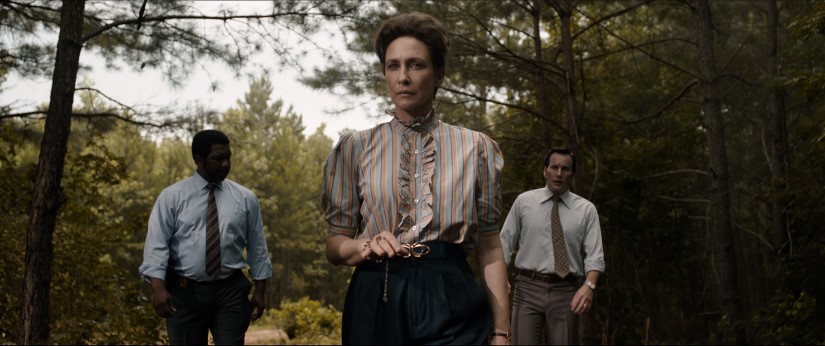
Can you talk about your approach to mixing that sequence in the woods?
MB: We spent a fair amount of time on that, exploring what we had and what we didn’t need, and also using the points that don’t have music to focus you more.
It was really about being precise.
It’s shot really well, so when Lorraine is in her dreamlike state in the woods, we experimented with having other winds and spooky stuff. It was kind of like the same idea of the bathroom, where things are really quiet. But you have these odd sounds way in the distance and then when those hands come around the tree, it’s not loud. It feels super dry and super close.
It was really about being precise. The forest lends itself to cool sounds, whether it’s tree creaking or even sounds like ice glaciers breaking in the distance and things that are organic but slightly off, that just pull your ear, making you become more and more unsettled.
[tweet_box]Behind ‘The Conjuring: The Devil Made Me Do It’s Credibly Creepy Sound[/tweet_box]
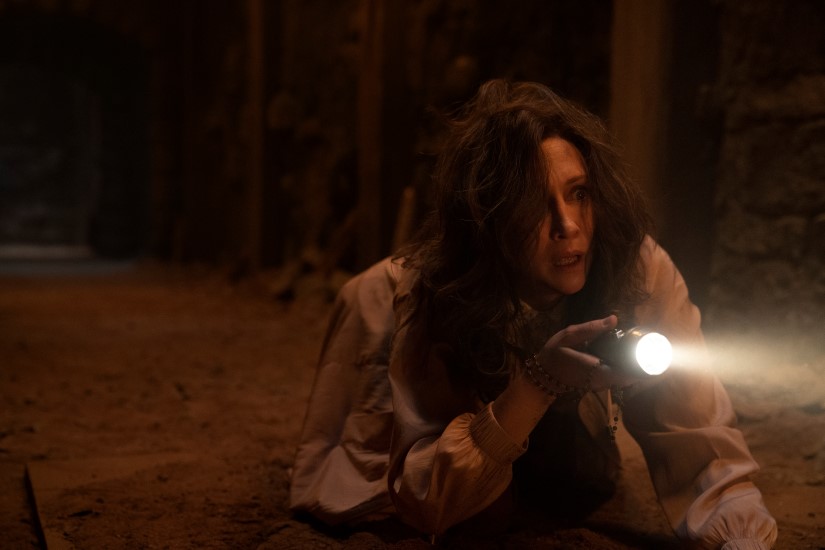
Lorraine’s visions were such a big part of this film’s soundscape. Are there other visions for which you’d like to share some sound design details?
JJ: Because each vision was unique there wasn’t necessarily a holistic approach to how they should sound. It was mostly about using the visions to foreshadow or recall story points, and finding clever ways to use the Atmos soundstage to our advantage. Placing sounds behind and above the audience, spinning the entire room, and panning sounds around in interesting ways.
The final visions near the end of the movie, when she is battling the witch, are particularly effective. I’d like to note that sound designers Jon Title and D. Chris Smith did a fantastic job with all of the visions throughout the film.
When Lorraine is standing at the witch’s altar attempting to destroy it, she has a double-vision experience where she can see things through her own eyes but also through the witch’s eyes at the same time. In the vision, we see through the witch’s eyes as she is walking down the corridor and hear a very stylized version of her footsteps. Then when we snap out of the vision and are back with Lorraine, we hear the witch’s footsteps continuing down the corridor but now they’re very distant. We switch back to the witch’s POV and the feet are strong and stylized, then go back to Lorraine and the feet are distant, but getting closer.
What if we use sound design to sell the idea of her getting closer through the way that Lorraine hears sound in her visions?
Michael’s idea was that it was akin to a chase sequence. Sonically, it was a bit of a puzzle: how do we play it in a way that feels like it’s close, it’s distant, it’s close, it’s closer but still distant, it’s close, it’s around the corner, it’s close, and now it’s right in the room with you?
That took a lot of experimentation, but it was such a cool idea. She has to destroy the altar before the witch can get to her. Michael’s decision to rely heavily on sound design to convey this chase was something that had come to him while working with picture editor Chris Wagner. What if we use sound design to sell the idea of her getting closer through the way that Lorraine hears sound in her visions? They worked up a temp version in the picture department, enough to explain the concept to us and say this is what we want to do, now take it to the next level.
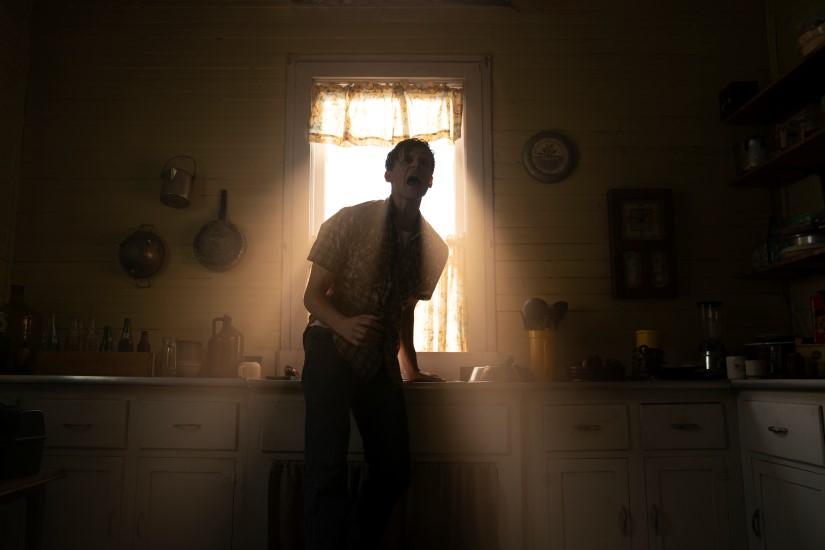
We talked about some quiet moments, but there’s also this moment near the beginning when Arne becomes possessed. The music is at 11 there! And there’s also cool music processing, slowing down the music to fit Arne’s POV. Can you talk about your challenges and opportunities for mixing that Blondie-driven sequence?
JS: That was a tough sequence to do because there are so many different ways of playing it. Essentially, what happened to Arne is he’s possessed. So, in one regard, it’s playing straight from everyone else’s perspective and it’s playing kind of crazy and screwed up from Arne’s perspective. It was a mixture of processing the Blondie track to screw it up, but then also, going back to Atmos, changing the spatiality of it. When it’s a more straight POV, we play it center down the front. And when we are in Arne’s head, I extrapolated it out into the heights and all the objects.
It was quite a tour de force and it took us quite a while to do. We experimented at first with having the multitracks. So I got a hold of the multitracks of Blondie and had a crack at the music while I was pre-dubbing. I would rather pre-dub that sequence than just leave it to the final.
The music multitracks just didn’t have the vibe of the Blondie track that we all know and love. It just didn’t sound the same. So we went back to the original two-track and I up-mixed that for Atmos and spread it out into the room and then just had fun with it. We wanted to make it a death-by-Blondie scene, as we called it.
The music multitracks just didn’t have the vibe of the Blondie track that we all know and love.
The movie starts off very quiet before David’s exorcism scene. We talked about the peaks and troughs and that exorcism scene is full-on. Everything in the objects is grabbing the audience by the scruff of the neck and saying to them, “Here we go! We’re going to take you on a crazy ride right now.” That’s the first big sequence. And then we come down to normal levels and the story starts kicking in. Then we go into that Blondie sequence.
So it’s trying to use the peaks and troughs of the Atmos environment to help us tell the story.
Bonus: Explore the Ultimate Horror Sound Guide:

MB: What was cool about that sequence was we would make a pass on it and everybody’s like, ‘Yeah, pretty cool. Pretty cool.’ And we kept coming back to it for various reasons, maybe because we didn’t have an element. But because we kept coming back to it, it kept getting better and better; we kept exploring and asking, “What can we do to make this better?”
But because we kept coming back to it, it kept getting better and better
For me, personally, it’s one of my favorite sequences in the movie. I certainly will never hear that song the same way again.
JS: I’m thankful to New Line; we were given the time to work on that sequence. Sometimes we’ve got to keep going because we’ve got an endpoint (and we did have an endpoint because we mixed quite up to the last moment), but we were never pressured to run through sequences without giving them their full day in the sun.
As Mike says, it was multiple passes and refining each time, figuring out how to go from straight Blondie to crazy Blondie and weird Blondie without making it jarring, finding the right crossover points to do it, and how far we could push it. It was good to have the time to work on that sequence.
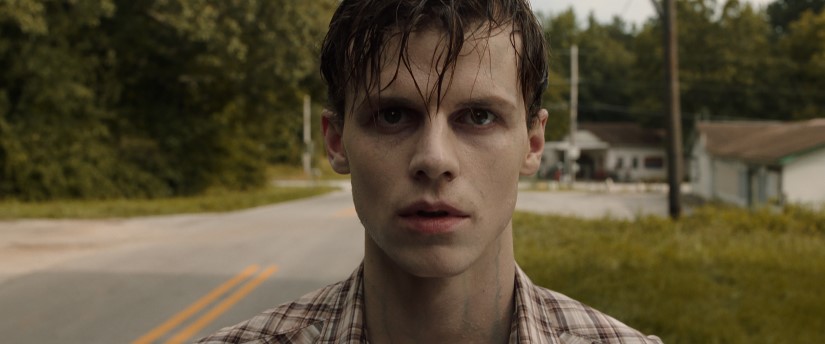
Were there any challenges when down-mixing that for streaming on HBO Max? Was it challenging to keep that intensity in the music level?
JS: I’d say yes it was challenging, because of the light and shade that our director insisted on. Like, at the end of that sequence, after Bruno comes forward and gets stabbed, you linger on this long hallway shot and in the very, very distance Blondie is still playing and it’s super quiet. It’s barely perceptible.
If you just lower the mix down because you’ve got to hit a certain spec for streaming, that distant music is going to just disappear off a cliff.
And that’s the kind of thing you’ve got to adjust for. If you just lower the mix down because you’ve got to hit a certain spec for streaming, that distant music is going to just disappear off a cliff. So it’s a constant process of not just monitoring the loud parts to get them to the correct level for the streaming environment. We had to do that and also make sure that the quiet things that we are playing with it — our story points and sometimes scare points — come through as well. So it’s reducing the dynamic range of the mix in a way that you feel doesn’t compromise the integrity of the original theatrical mix.
Thankfully, we were given time to do that. Warner Bros. understands the value of giving the mixers the time to do that.
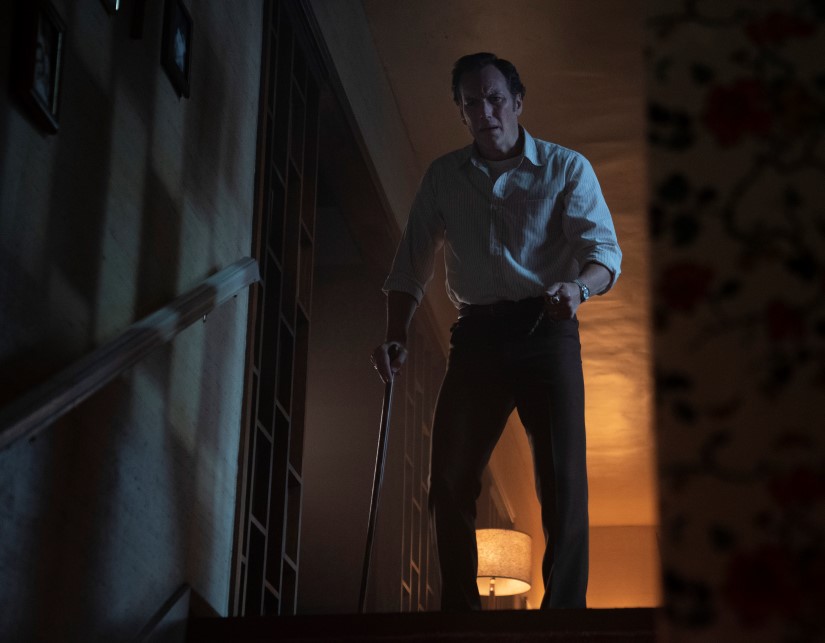
Did you have a favorite scene to mix and why?
MB: I have a couple of favorite moments as the effects mixer. It’s a relatively small place, but one of my favorite moments is when Ed wakes up on a bed at home but he’s in a different space, a different perception of reality. That whole area is one of my favorite moments. There’s this kind of imperceptible thing that’s going on, where there’s just sound going on for a long period of time. And suddenly Ed wakes up on the bed and you just have this feeling of like, ‘Oh, something is definitely off.’ And he’s walking through the house in this kind of different dimension. And the wind feels a little bit off, things feel a little bit open, and he ends up meeting the witch. That is my favorite area. That was the most fun to do and the most fun to listen to consistently.
It goes completely quiet and literally, for about a second, you think, ‘Ooh, have the speakers turned off?’
JS: I’d say the forest, for me, was one of my favorites. I love that moment in the forest when Lorraine goes into her vision and it goes from day to night and we suck the air out of the room. It goes completely quiet and literally, for about a second, you think, ‘Ooh, have the speakers turned off?’ And then you hear the very faintest foley move as she moves. And you’re like, ‘ Oh no. Something is happening. It’s not a technical error.’ And I just love it. I think it’s a really cool moment. And Jay did such a good job with the sound design. That forest sequence is pretty cool, I think.
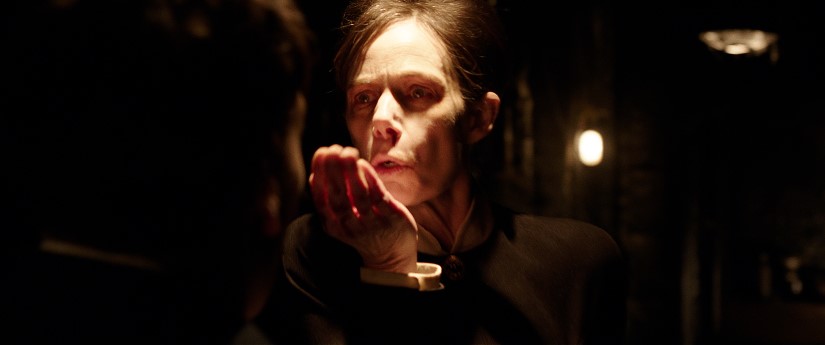
What are you most proud of in terms of your sound work on The Conjuring: The Devil Made Me Do It?
JS: Personally, I think it’s a great dynamic mix that is healthy-loud in the right places and super quiet in the quiet places yet you can hear the detail.
It’s just a great-sounding movie and the fact that it’s the third one in a franchise is even better. It has so many great sound moments. I’m really proud of it as a piece.
MB: My answer is pretty much the same. It’s super dynamic, but not painful.
JJ: Movies shouldn’t be loud all the time. It’s okay to be dynamic. I think The Conjuring 3 is a great example of a movie that really showcases that. Of all the concepts we explored in the process with Michael, this was probably the one we focused in on the most.
A big thanks to Jay Jennings, Mike Babcock, and Julian Slater for giving us a behind-the-scenes look at the sound of The Conjuring: The Devil Made Me Do It and to Jennifer Walden for the interview!

